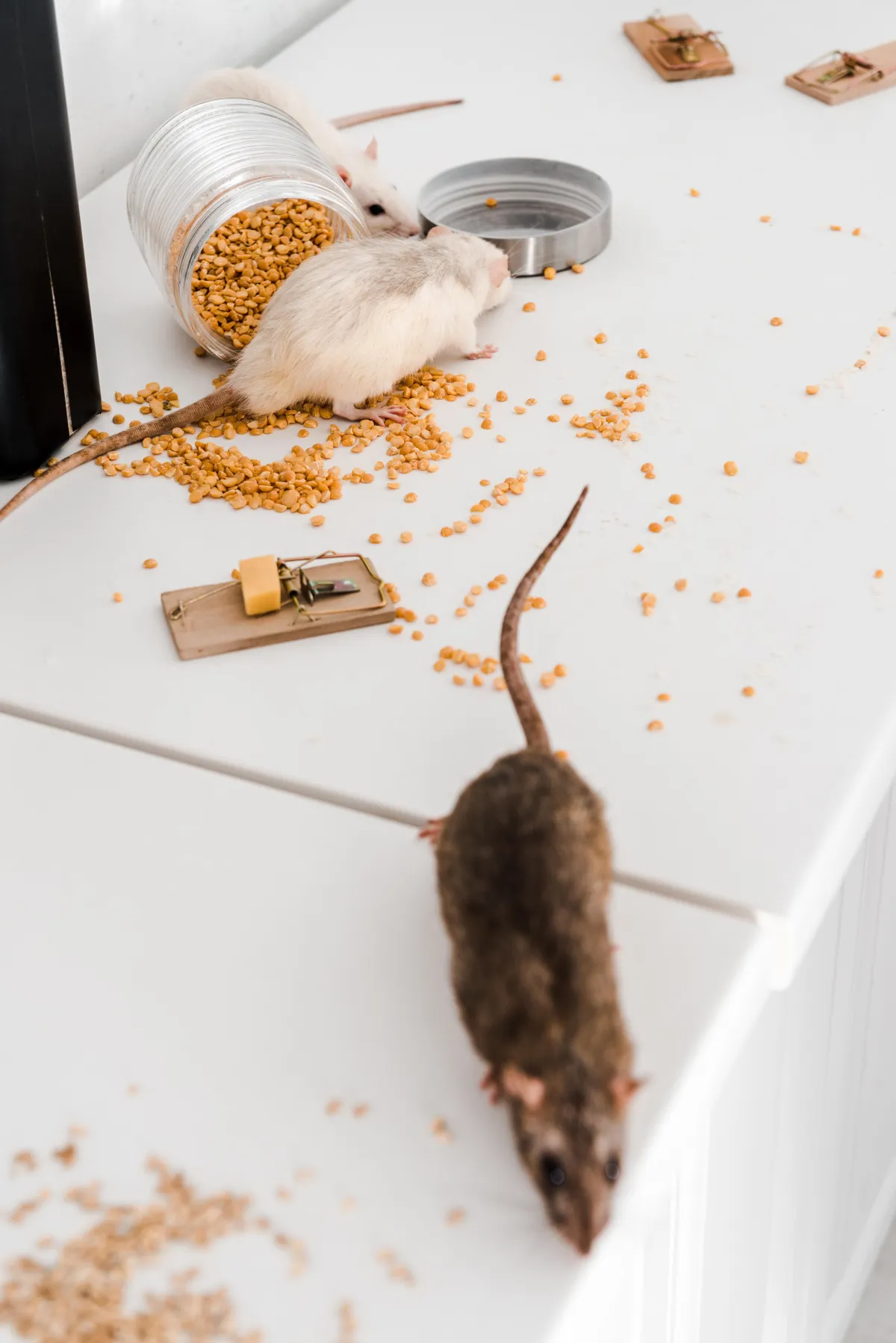
Professional Rodent Control Services
Professional Solutions for Rodent Infestations
Rodents like mice and rats can infest your home at any given moment. While they primarily live outdoors, these pests often seek shelter in homes and buildings, especially during colder months. Once inside, they can spread disease, damage property, and contaminate food. Our professional rodent control services provide targeted solutions to eliminate these dangerous pests from your home and prevent future infestations.

Understanding Rodents
What Are Rodents?

Rodents are warm-blooded mammals characterized by their continuously growing incisor teeth that require constant gnawing to keep them at a manageable length. The most common household rodent pests are rats and mice. These adaptable creatures have thrived alongside human populations for centuries, taking advantage of the shelter, food, and water that our homes and buildings provide, particularly during harsh weather conditions.
Rodent Characteristics
Appearance: Furry bodies with long tails, pointed snouts, and large incisors
Size: Range from small (house mice at 2-3 inches) to larger (rats at 7-10 inches) not including tail
Colony Structure: Social animals that live in groups with hierarchical structures
Lifespan: Complete development from birth to sexual maturity within weeks
Diet: Omnivorous, consuming almost anything including grains, fruits, meats, and household items
Common Household Rodent Species
Several factors can make your home attractive to rodents:
Norway Rat Size:
Size: 7-10 inches long with a 6-8 inch tail
Color: Brown or gray with a lighter underside
Behavior: Burrows in the ground, often nests in basements and lower levels
Concern: Can cause substantial structural damage and spread numerous diseases
Roof Rat:
Size: 6-8 inches long with a tail longer than body length
Color: Black or dark brown with a lighter underside
Behavior: Excellent climbers that prefer elevated areas like attics and upper floors
Concern: Can chew through wiring causing fire hazards and contaminate food sources
House Mouse
Size: 2-3 inches long with a 3-4 inch tail
Color: Light brown to gray with a lighter underside
Behavior: Nests close to food sources, often inside walls and hidden areas
Concern: Reproduces rapidly with females producing up to 10 litters per year
Signs of a Rodent Infestation
You may have a rodent problem if you notice:

Droppings:
Small pellet-shaped feces along walls, in drawers, or near food sources
Gnaw Marks:
Teeth marks on food packaging, furniture, wires, or structural elements
Rub Marks:
Dark, greasy smears along walls and baseboards from their oily fur
Nests:
Collections of shredded paper, fabric, or plant material in hidden areas
Hidden Indications
Urine Pillars:
Accumulations of urine that combine with dirt and dust forming distinct structures
Tracks:
Footprints or tail drag marks visible in dusty areas or mud outside
Unusual Pet Behavior:
Pets pawing at walls or floors where rodents may be present
Distinctive Odor:
Musty, ammonia-like smell from urine, especially with large infestations
The Risks of Rodent Infestations
Rodents can cause several problems in your home:

Disease Transmission:
Rodents can spread numerous diseases through their droppings, urine, and bites
Rodent Bites:
When cornered, rats will bite to defend themselves, potentially transmitting disease
Rapid Multiplication:
Rodents reproduce quickly, leading to large infestations if not addressed promptly
Property Damage:
Can chew through wiring, insulation, drywall, and even lead pipes
Food Contamination:
Rodents contaminate far more food than they actually consume
Our Comprehensive Rodent Control Approach
We take a multi-faceted approach to rodent control:
Thorough Inspection
Our technicians will conduct a detailed inspection to:
Identify the specific rodent species present
Locate nesting areas, entry points, and travel routes
Determine the extent of the infestation
Identify contributing factors that may be enabling the infestation


Customized Treatment Plan
Based on our findings, we'll develop a tailored rodent control strategy that may include:
Exclusion Methods
Sealing entry points and holes to "rodent proof" your property
Installing door sweeps and screens on vents
Addressing gaps around pipes and utility lines
Trapping & Removal
Strategic placement of traps in high-activity areas
Regular monitoring and removal of captured rodents
Use of specialized equipment for hard-to-reach areas
For Long-term Prevention
Sanitizing droppings, nests, and travel paths to address bacteria
HEPA vacuum removal of droppings that contribute to airborne diseases
Removal of soiled insulation if necessary

Prevention Strategies
We'll help prevent future rodent problems by: Identifying and sealing potential entry points
Recommending proper food storage and waste management practices
Suggesting landscape modifications to reduce outdoor harborage
Advising on regular inspection and maintenance routines
Follow-Up Protection
Our commitment to rodent control includes: Scheduled follow-up visits to ensure complete elimination
Long-term monitoring with bait stations if necessary
Additional treatments as needed
Continuous protection against future infestations
Rodent Prevention Tips
To help keep rodents away from your home:
Home Maintenance
Seal cracks and holes in foundation and exterior walls
Install door sweeps and repair damaged screens
Store firewood at least 20 feet from your home
Trim tree branches away from roof and walls
Food Management
Store food (including pet food) in airtight containers
Clean up crumbs and spills promptly
Empty garbage regularly and use rodent-proof bins
Keep bird feeders away from the house
Yard Maintenance
Remove dense vegetation against foundation
Keep grass trimmed short around the house
Eliminate standing water sources
Keep compost bins tightly covered and away from the house
The Risks of Rodent Infestations
Rodents can cause several problems in your home:
Health Concerns Disease Transmission:
Health Concerns Disease Transmission: Rodents can carry hantavirus, leptospirosis, salmonellosis, and many other diseases
Allergic Reactions: Their dander, urine, and droppings can trigger asthma and allergies
Parasites: Rodents often carry fleas, ticks, and mites that can infest pets and humans.
Property Damage Structural Issues:
Property Damage Structural Issues: Their constant gnawing can damage walls, floors, and support beams
Fire Hazards: Chewing on electrical wires can create fire risks
Fire Hazards: Chewing on electrical wires can create fire risks
Our Rodent Control Guarantee
We stand behind our services with our satisfaction guarantee. If rodents return between scheduled treatments, so will we—at no additional cost to you.
Frequently Asked Questions
Get answers to common questions about rodents
What’s the deference between roof rats and packrats?
Roof rats are agile climbers that often nest in attics, while packrats (woodrats) are more likely to build messy nests in garages, sheds, or outdoor clutter. Both carry disease and chew on wiring.
How do you get rid of rodents?
We use a combination of baiting (Selontra®), exclusion, and habitat modification to eliminate rodents. For long-term results, we seal o entry points and provide ongoing monitoring.
Say Goodbye to Fleas For Good
Don't let rodents threaten your family's health and damage your property. Our professional rodent control services provide effective, lasting solutions to eliminate these dangerous pests.
We guarantee your satisfaction—if rodents return between scheduled treatments, so will we at no additional cost.



COMPANY
LEGAL
Contact
© Copyright 2025. Desert Shield Pest Control. All Rights Reserved.
